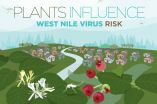Research letter: Indoor tanning rates drop among US adults
2015-07-01
(Press-News.org) Indoor tanning rates dropped among adults from 5.5 percent in 2010 to 4.2 percent in 2013, although an estimated 7.8 million women and 1.9 million men still engage in the practice, which has been linked to increased cancer risk, according to the results of a study published online in a research letter by JAMA Dermatology.
Gery P. Guy Jr., Ph.D., M.P.H., of the Centers for Disease Control and Prevention, Atlanta, and coauthors analyzed data for 59,145 individuals from the 2010 and 2013 National Health Interview Survey, a nationally representative sample of U.S. adults.
In addition to the overall reduction, the authors identified decreases in indoor tanning rates among individuals ages 18 to 29 (11.3 percent in 2010 to 8.6 percent in 2013), women (8.6 percent in 2010 to 6.5 percent in 2013), and men (2.2 percent in 2010 to 1.7 percent in 2013).
Among women who indoor tanned, the frequency was 28 percent lower among the oldest group, 45 percent lower among college graduates, 33 percent lower among women in fair or poor health and 23 percent lower among women meeting aerobic or strength physical activity criteria. However, indoor tanning frequency among men was 177 percent higher among men age 40 to 49 and 71 percent higher in men age 50 or older but 45 percent lower among cancer survivors, according to the results.
The authors suggest the decrease in indoor tanning may be partly attributable to increased awareness of its harms as indoor tanning devices have been classified as carcinogenic to humans, laws restricting access by minors have been enacted and a 10 percent excise tax on indoor tanning has been implemented.
The authors caution a causal inference cannot be made between behaviors and the frequency of indoor tanning from their data.
"Research regarding the motivations of indoor tanners could inform the development of new interventions. Physicians can also play a role through behavioral counseling, which is recommended for fair-skinned persons aged 10 to 24 years. Continued surveillance of indoor tanning will aid program planning and evaluation by measuring the effect of skin cancer prevention policies and monitoring progress," the study concludes.
INFORMATION:
(JAMA Dermatology. Published online July 1, 2015. doi:10.1001/jamadermatol.2015.1568. Available pre-embargo to the media at http://media.jamanetwork.com.)
Editor's Note: Please see the article for additional information, including other authors, author contributions and affiliations, financial disclosures, funding and support, etc.
Media Advisory: To contact corresponding author Gery P. Guy Jr., call Brittany Behm at 404-639-3286 or email media@cdc.gov.
ELSE PRESS RELEASES FROM THIS DATE:
2015-07-01
New York, NY (July 1, 2015) -- Despite concerns that use of antipsychotic medications in treating young people has increased, use actually declined between 2006 and 2010 for children ages 12 and under, and increased for adolescents and young adults.
In a study published today in JAMA Psychiatry, Mark Olfson, MD, MPH, of Columbia University Medical Center (CUMC) and NYS Psychiatric Institute, and his colleagues analyzed prescription data from 2006-2010 to identify trends in the use of antipsychotic medications in young people in the United States.
They found that boys ...
2015-07-01
Boys are more likely than girls to receive a prescription for antipsychotic medication regardless of age, researchers have found. Approximately 1.5 percent of boys ages 10-18 received an antipsychotic prescription in 2010, although the percentage falls by nearly half after age 19. Among antipsychotic users with mental disorder diagnoses, attention deficit hyperactivity disorder (ADHD) was the most common among youth ages 1-18, while depression was the most common diagnosis among young adults ages 19-24 receiving antipsychotics.
Despite concerns over the rising use of ...
2015-07-01
As fireflies are delighting children across the country with their nighttime displays, scientists are closing in on a better understanding of how the insects produce their enchanting glow. They report in the Journal of the American Chemical Society new evidence of how the beetles' chemistry works. Their findings could apply to the bioluminescence of other organisms, too.
About 60 years ago, scientists figured out in broad strokes the cascade of reactions that allows fireflies to produce light. It starts with a chemical called luciferin, which interacts with the energy-transporting ...
2015-07-01
CHAMPAIGN, Ill. -- A new study looks at how leaf litter in water influences the abundance of Culex pipiens mosquitoes, which can transmit West Nile virus to humans, domestic animals, birds and other wildlife.
The study found that different species of leaf litter in standing water influence where Culex pipiens mosquitoes deposit their eggs, how quickly the larvae grow, how big they get and whether they survive to adulthood. Because the mosquitoes feed on bacteria that grow on leaf litter, the team also measured how native and non-native leaf species influenced bacterial ...
2015-07-01
Living with Type 1 diabetes requires constant monitoring of blood sugar levels and injecting insulin daily. Now scientists are reporting in the ACS journal Industrial & Engineering Chemistry Research the development of an implantable "artificial pancreas" that continuously measures a person's blood sugar, or glucose, level and can automatically release insulin as needed.
Type 1 diabetes, previously known as juvenile diabetes, affects about 1.25 million Americans. About 200,000 of them are under 20 years old. The condition arises when a person's own immune system destroys ...
2015-07-01
MOOCs -- massive open online courses -- grant huge numbers of people access to world-class educational resources, but they also suffer high rates of attrition.
To some degree, that's inevitable: Many people who enroll in MOOCs may have no interest in doing homework, but simply plan to listen to video lectures in their spare time.
Others, however, may begin courses with the firm intention of completing them but get derailed by life's other demands. Identifying those people before they drop out and providing them with extra help could make their MOOC participation much ...
2015-07-01
The production of petroleum from Canada's oil sands is on the rise with much of it destined for U.S. refineries. As the U.S. takes stock of its greenhouse gas emissions, scientists report in the ACS journal Environmental Science & Technology that the current oil sands production of fuels from "well-to-wheels" releases about 20 percent more carbon dioxide into the atmosphere than making gasoline and diesel from conventional crudes.
In 2013, the oil industry was producing nearly 2 million barrels per day from Canadian oil sands. By 2030, that number is expected to rise ...
2015-07-01
JILA researchers have designed a microscope instrument so stable that it can accurately measure the 3D movement of individual molecules over many hours--hundreds of times longer than the current limit measured in seconds.*
The technology was designed to track the machinery of biological cells, down to the tiniest bits of DNA, a single "base pair" of nucleotides among the 3 billion of these chemical units in human genes. But the instrument could be useful well beyond biology, biochemistry and biophysics, perhaps in manufacturing.
JILA is a partnership of the National ...
2015-07-01
GRAND RAPIDS, Mich., June 24, 2015 - Researchers at Spectrum Health Helen DeVos Children's Hospital have completed the first clinical trial of a new treatment for children suffering from neuroblastoma. In a clinical trial led by Giselle Sholler, MD, pediatric oncologist at Helen DeVos Children's Hospital and the Neuroblastoma and Medulloblastoma Translational Research Consortium (NMTRC), DFMO, an investigational agent, showed minimal side effects with long-term survival of three patients. This is the first clinical study of an oral dosing form of DFMO in any pediatric population. ...
2015-07-01
Scientists have at their disposal a way to explore the possible prevention of genetic diseases before birth. But should they? Currently, the most promising path forward involves editing the genes of human embryos, a procedure rife with controversy. An article in Chemical & Engineering News (C&EN), the weekly newsmagazine of the American Chemical Society, parses the explosive issue.
Britt E. Erickson, a senior editor at C&EN, reports that at least one team of scientists has already published a study on altering disease-related genes of human embryos. The experiment was ...
LAST 30 PRESS RELEASES:
[Press-News.org] Research letter: Indoor tanning rates drop among US adults

